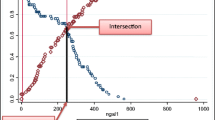Abstract
Objective
To evaluate the utility of urinary Neutrophil Gelatinase Associated Lipocalin (NGAL) as a biomarker for predicting Acute Kidney Injury (AKI) and its severity among neonates with perinatal asphyxia.
Methods
This descriptive study included 120 term neonates with perinatal asphyxia. Renal parameters of neonates were monitored and AKI was ascertained as per Acute Kidney Injury Network criteria. Urinary NGAL was estimated and correlated with severity of AKI.
Results
Among the 120 neonates with perinatal asphyxia, 55(46 %) had AKI. The median urinary NGAL level was 165 ng/ml (88.8–245.8) in neonates with AKI compared to 58.97(42.8–74.7) in those without AKI. The median NGAL was 134.45(112.2–162.5), 301.2(255.5–361.2), 416.2(412.2–465.5) in AKI stages 1, 2 and 3 respectively. An NGAL cut off value of 86.82 ng/ml had 87 % sensitivity and 87.7 % specificity in predicting AKI.
Conclusions
Urinary NGAL is a useful biomarker for predicting AKI and its severity among neonates with perinatal asphyxia.


Similar content being viewed by others

References
Ambalavanan N, Carlo, WA. Hypoxic ischemic encephalopathy. Nelson Text book of Pediatrics. 19th ed. In: Kleigman, RM, Geme, JW, Stanton, BF, Behrman, RE, et al editors. Philadelphia: Elsevier; 2012. p. 569–573.
Raggal NE, Khafagy SM, Mahmoud NH, Beltagy SE. Serum neutrophil gelatinase-associated lipocalin as a marker of acute kidney injury in asphyxiated neonates. Indian Pediatr. 2013;50:459–62.
Hjortrup PB, Haase N, Wetterslev M, Perner A. Clinical review: predictive value of neutrophil gelatinase-associated lipocalin for acute kidney injury in intensive care patients. Crit Care. 2013;17:211.
Armstrong L, Stenson BJ. Use of umbilical cord blood gas analysis in the assessment of the newborn. Arch Dis Child Fetal Neonatal Ed. 2007;92:F430–4.
Jain L. Severe perinatal asphyxia and Apgar scores. Am J Dis Child. 1987;141:1253.
Kjeldsen L, Cowland JB, Borregaard N. Human neutrophil gelatinase-associated lipocalin and homologous proteins in rat and mouse. Biochim Biophys Acta. 2000;1482:272–83.
Soni SS, Cruz D, Bobek I, et al. NGAL: a biomarker of acute kidney injury and other systemic conditions. Int Urol Nephrol. 2010;42:141–50.
Mishra J, Ma Q, Prada A, et al. Identification of neutrophil gelatinase-associated lipocalin as a novel early urinary biomarker for ischemic renal injury. J Am Soc Nephrol. 2003;14:2534–43.
Sarafidis K, Tsepkentzi E, Agakidou E, et al. Serum and urine acute kidney injury biomarkers in asphyxiated neonates. Pediatr Nephrol. 2012;27:1575–82.
Askenazi D. Are we ready for the clinical use of novel acute kidney injury biomarkers? Pediatr Nephrol. 2012;27:1423–5.
Haase M, Bellomo R, Devarajan P, Schlattmann P, Haase-Fielitz A, NGAL Meta-analysis Investigator Group. Accuracy of neutrophil gelatinase-associated lipocalin (NGAL) in diagnosis and prognosis in acute kidney injury: a systematic review and meta-analysis. Am J Kidney Dis. 2009;54:1012–24.
Bharadwaj SK, Bhat BV. Therapeutic hypothermia using gel packs for term neonates with hypoxic ischaemic encephalopathy in resource-limited settings: a randomized controlled trial. J Trop Pediatr. 2012;58:382–8.
Tanigasalam V, Bhat V, Adhisivam B, Sridhar MG. Does therapeutic hypothermia reduce acute kidney injury among term neonates with perinatal asphyxia? – a randomized controlled trial. J Matern Fetal Neonatal Med. 2016;29:2544–7.
Askenazi DJ, Ambalavanan N, Goldstein SL. Acute kidney injury in critically ill newborns: what do we know? What do we need to learn? Pediatr Nephrol. 2009;24:265–74.
Mehta RL, Kellum JA, Shah SV, et al. Acute kidney injury network: report of an initiative to improve outcomes in acute kidney injury. Crit Care. 2007;11:R31.
Hankins GD, Koen S, Gei AF, Lopez SM, Van Hook JW, Anderson GD. Neonatal organ system injury in acute birth asphyxia sufficient to result in neonatal encephalopathy. Obstet Gynecol. 2002;99:688–91.
Durkan AM, Alexander RT. Acute kidney injury post neonatal asphyxia. J Pediatr. 2011;158:e29–33.
Selewski DT, Jordan BK, Askenazi DJ, Dechert RE, Sarkar S. Acute kidney injury in asphyxiated newborns treated with therapeutic hypothermia. J Pediatr. 2013;162:725–9.e1.
Gupta BD, Sharma P, Bagla J, Parakh M, Soni JP. Renal failure in asphyxiated neonates. Indian Pediatr. 2005;42:928–34.
Aggarwal A, Kumar P, Chowdary G, Majumdar S, Narang A. Evaluation of renal functions in asphyxiated neonates. J Trop Pediatr. 2005;51:295–9.
Karlowicz MG, Adelman RD. Non oliguric and oliguric ARF in asphyxiated term neonates. Pediatr Nephrol. 1995;9:718–22.
Karlo J, Bhat BV, Koner BC, Adhisivam B. Evaluation of renal function in term babies with perinatal asphyxia. Indian J Pediatr. 2014;81:243–7.
Suchojad A, Tarko A, Smertka M, et al. Factors limiting usefulness of serum and urinary NGAL as a marker of acute kidney injury in preterm newborns. Ren Fail. 2015;37:439–45.
Krawczeski CD, Woo JG, Wang Y, Benett MR, Ma Q, Deverajan P. Neutrophil gelatinase-associated lipocalin concentrations predict development of acute kidney injury in neonates and children after cardiopulmonary bypass. J Pediatr. 2011;158:1009–15.e1.
Lavery AP, Meinzen-Derr JK, Anderson E, et al. Urinary NGAL in premature infants. Pediatr Res. 2008;64:423–8.
Jayashree G, Dutta AK, Sarna MS, Saili A. Acute renal failure in asphyxiated newborns. Indian Pediatr. 1991;28:19–23.
Contributions
VT: Collected and analyzed the data; BVB: Designed and supervised study; BA: Drafted manuscript and critically analyzed data; MGS: Helped with lab investigations; KTH: Helped in data analysis. BVB will act as guarantor for the paper.
Author information
Authors and Affiliations
Corresponding author
Ethics declarations
Conflict of Interest
None.
Source of Funding
Intramural research grant from JIPMER, Puducherry.
Rights and permissions
About this article
Cite this article
Tanigasalam, V., Bhat, B.V., Adhisivam, B. et al. Predicting Severity of Acute Kidney Injury in Term Neonates with Perinatal Asphyxia Using Urinary Neutrophil Gelatinase Associated Lipocalin. Indian J Pediatr 83, 1374–1378 (2016). https://doi.org/10.1007/s12098-016-2178-z
Received:
Accepted:
Published:
Issue Date:
DOI: https://doi.org/10.1007/s12098-016-2178-z



